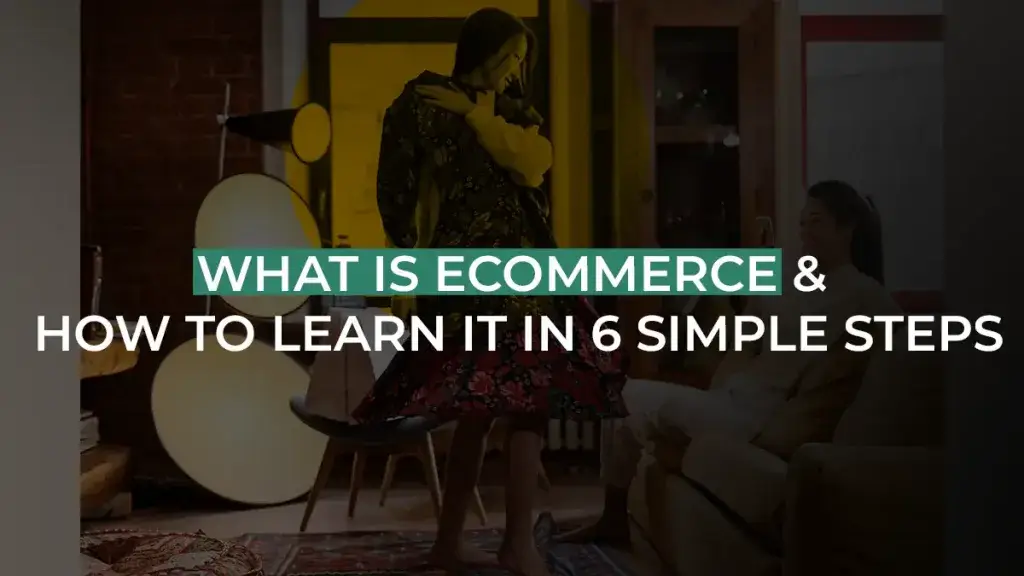What is E-commerce & How To Learn It in 6 Simple Steps

Here's What We've Covered!
Ever wondered about a world where your shopping journey begins with a question or unfolds like a captivating story? Ecommerce, or electronic commerce, brings this fantasy to life, making every transaction an online adventure. It’s not just a trend, it’s a transformation, weaving a new era for commerce.
Understanding “What is e-commerce?” holds immense significance in our current economy. It marks a shift where businesses go beyond borders, connecting with a global audience. The ease of online transactions empowers consumers, allowing them to shop from the comfort of home. As we dive into mastering e-commerce, a solid grasp of its fundamentals is crucial for navigating the digital marketplace. Let’s unfold the key steps to flourish in this dynamic field.
Understanding Ecommerce
Ever wondered what an e-commerce tick is? It’s not just a buzzword; it’s the digital magic that transforms how we buy and sell, seamlessly blending the online world into our daily commerce mix.
Let’s stroll back to the 1960s when the seeds of e-commerce were planted. From basic online transactions, it’s evolved dynamically, mirroring the global shift in our economy to a digital landscape.
Now, e-commerce isn’t a one-size-fits-all deal; it’s like a versatile tapestry weaving different models. There’s B2B, where businesses waltz through transactions among themselves. B2C takes a more direct route, with businesses showcasing their goods directly to you, the consumer. Then there’s C2C, adding a personal touch as consumers become buyers and sellers, engaging in a vibrant exchange ecosystem.
Now let’s delve deeper to understand this in detail.
Business to Business Transactions (B2B):
B2B is where businesses gracefully wear both buyer and seller hats, dealing in bulk purchases and services – the backbone of industrial and corporate commerce.
Companies like Alibaba is one such example. This giant facilitates bulk transactions, connecting businesses worldwide for wholesale purchases and services.
Business to Customer Transactions (B2C):
B2C is a more direct approach where businesses showcase their products or services directly to consumers. The online retail vibe makes our digital shopping experience simple and straightforward that is just a few clicks away.
For example, Amazon is considered the online retail powerhouse that directly offers a vast array of products to individual consumers, streamlining the purchasing process between business and customer with a click.
Customer to Customer Transactions (C2C):
C2C adds a personal touch. Here consumers become both buyers and sellers, engaging in transactions with fellow consumers. Picture a community-driven commerce, where individuals contribute to a thriving exchange ecosystem.
eBay is a standout example in this space. It provides a platform where individual consumers can buy and sell directly from each other, fostering a dynamic community-driven exchange.
Understanding these e-commerce strokes is like learning an artist’s palette – each model contributes to the masterpiece of online business. It’s not just about transactions; it’s about grasping the dynamics fueling them in different settings.
Do you want to go even further in understanding this artistic palette? At IMS Proschool, agency specialists with expertise from MICA, IITs, and IIMs share their knowledge in IMS Proschool’s digital marketing course, where you can learn all about e-commerce and marketing.
Check out IMS Proschool’s digital marketing course right away to expand your horizons about digital marketing in e-commerce!
Ready to uncover more? Let’s seamlessly transition into the next chapter, exploring “The Key Components Of E-commerce.”
Also Read – Importance of social media marketing for your eCommerce business
Rise of Ecommerce:
In the ever-evolving saga of shopping, e-commerce stands as the protagonist, reshaping our purchasing landscape. According to recent reports by Forbes Advisor, The global e-commerce market is expected to total $6.3 trillion in 2023. These numbers not only showcase a mere trend but signify a formidable force, with a growth rate that defies expectations.
So, whether it’s your local artisan crafting unique pieces or international giants like Amazon and Alibaba, everyone is boarding the digital commerce train. It’s not just about transactions; it’s a global marketplace phenomenon, where technology leads the way. Get ready to witness the ascent of e-commerce, where numbers tell a compelling story and technology takes the helm, reshaping the dynamics of how we engage in commerce in this digital age.
Key Components of Ecommerce:
E-commerce is like a digital symphony, and its key components play distinct roles in crafting a seamless online experience.
- Website: It is your dynamic digital storefront where products shine, offering an immersive shopping journey virtually.
- Shopping Cart: It’s more than a container; and your quiet assistant bridging exploration and purchase. For example Walmart’s digital basket efficiently managing selected items.
- Payment Gateway: The maestro of security, encrypting sensitive information for a safe financial harmony. Consider PayPal’s secure transactions with advanced encryption as a great option.
- Inventory, Orders, and Shipping: Expansion into inventory management, order processing, and shipping logistics adds layers to the e-commerce symphony. Efficient coordination of these elements ensures seamless orchestration, preventing chaos, and enhancing the overall customer experience.
- User Experience: Your website’s design, navigation ease, and interface responsiveness set the stage for an immersive encounter. A well-designed site doesn’t just attract; it captivates and retains visitors, transforming them from passive observers into active participants in your e-commerce performance. For example, Apple’s sleek design mirrors simplicity and captivates users across devices.
- Security Measures: Implementing robust security measures is akin to ensuring the safety of the digital stage. Protocols such as SSL certificates and two-factor authentication act as the bouncers, guarding against unauthorised access and providing customers with the assurance that their sensitive data is shielded from prying eyes.
This ensemble harmonizes to create an immersive e-commerce symphony, setting the stage for success. Explore these components to master the art of e-commerce with IMS Proschool’s digital marketing course, led by experts from MICA, IITs, and IIMs.
Now, let’s seamlessly progress to the six simple steps for real-world e-commerce success!
Learning Ecommerce In 6 Simple Steps
Step 1: Grasping Ecommerce Essentials
Start your ecommerce journey by having an understanding of the digital marketplace. Start by familiarising yourself with essential e-commerce terminology, demystifying the jargon that permeates this dynamic industry. Learning these key terms is akin to equipping yourself with a valuable toolkit, essential for navigating the ins and outs of online commerce.
But why does it matter?
Mastering the fundamentals of e-commerce sets the stage for success in the online business. It provides a holistic view of the intricacies of digital commerce, empowering savvy decision-making and strategic planning.
Top Resources to master the e-commerce basics:
- Industry Blogs:
- E-commerce Fuel
- Shopify Blog
- Practical Ecommerce
- Forums:
- eCommerce Reddit Community
- Warrior Forum – eCommerce Section
- Online Courses:
- IMS Proschool: “Digital Marketing Course”
- Coursera: “E-commerce Essentials”
Once you master the basic e-commerce concepts it will empower you to communicate effectively within the e-commerce landscape, fostering confidence in your digital business endeavours. As you navigate this foundational step, consider it the key to unlocking the doors of the vast e-commerce realm.
Also Read – How to Use Storytelling While Marketing
Step 2: Undertake Market Research
Begin by understanding your audience and decoding their preferences. It’s an insightful journey into the minds of your potential customers, seeking to comprehend their needs and expectations.
Along with this, Competitor Analysis is also a crucial part of the market research. It becomes your strategic telescope that allows you to observe the moves and strategies of established players in your niche. Explore the products they offer, their pricing strategies, and customer reviews. This information is invaluable for positioning your e-commerce venture strategically within the competitive landscape.
Here are some techniques to facilitate market research:
- Understanding your Target Audience:
Use Demographic Analysis, Customer Surveys and Social Media Listening to break down your audience preferences, sentiments, and behaviour and then design your e-commerce strategy.
- Analyzing your Competition:
Use Competitor Websites, Customer Reviews, and SWOT Analysis to scrutinize your competition, understand their product offerings, pricing strategies, identify gaps and areas for improvement.
- Keyword Research:
Use SEO Tools, Google Keyword Planner, Google Trends to identify relevant keywords in your industry, optimize your online presence and keep an eye on trending topics related to your products or services.
- Industry Reports and Publications:
Reading Market Reports and Trade Publications will help you gain insights into market trends, forecasts, and emerging opportunities.
- Customer Feedback and Test Groups:
Beta Testing and Focus Groups helps to gather valuable feedback and gain qualitative insights into customer preferences and perceptions.
Step 3: Setting Up Your Ecommerce Store
Selecting the right e-commerce platform is a pivotal decision, similar to choosing the ideal location for a physical store. Therefore, take into consideration following factors as you set up your E-commerce Store :
- Scalability: Evaluate the platform’s capacity to grow alongside your business. Assess whether it can accommodate an expanding product range and increasing customer base.
- Ease of Use: Opt for a platform with an intuitive interface, making it easy for you to manage products, track orders, and interact with customers. User-friendly platforms contribute to a smoother operational workflow.
- Features: Identify the features offered by each platform. From payment gateways to customization options, choose a platform that aligns with your business requirements. Some platforms may offer built-in templates and tools for marketing, inventory management, and analytics.
At Proschool – you learn everything, How to build and maintain website, performance marketing, social media marketing, analytics & more
Step 4: E-commerce SEO and Digital Marketing
With your fortress established, it’s time to announce your presence to the world. SEO and digital marketing become the sail of your ship, catching the wind and propelling you forward. Mastering SEO basics is akin to having a secret map that leads customers straight to your treasure chest.
Wondering where can you master this art of digital marketing and SEO? Then worry no further, IMS Proschool is a great platform for students as well as working professionals who wish to develop the skills of marketing along with their other priorities. So, visit Proschool website today and enroll in their upcoming online/offline batches!
Step 5: Managing E-commerce Operations
Fine-tune your crew and operations to ensure efficiency becomes the wind in your sails. Master inventory management using tools to Demand Forecasting and Real Time Tracking of stock levels to avoid overstocking and wastage.
Streamline the order fulfilment Processes to avoid day to day hassle, collaborating with reliable shipping partners and building order tracking systems so that customers can monitor the status of their purchases and on time deliveries.
Developing an expertise in these process will automatically lead to top-notch customer experience, turning satisfied customers into loyal allies and contributing to the growth of your e-commerce fleet.
Also Read – How Digital Marketing is helping E-commerce to Grow
Step 6: Analytics and Optimization
In the vast sea of e-commerce, data becomes your navigator. Invest into learning the analytics tools and start tracking key performance indicators (KPIs) such as sales, conversion rates, and customer satisfaction. These insights will help you understand your business better and take informed data driven decisions to optimize e-commerce operations and improve overall efficiency. Continuous refinement based on these data-driven insights ensures your e-commerce fleet stays afloat and sails ahead of the competition.
As each step unfolds a chapter in your e-commerce saga, offering actionable insights and skills for a fulfilling journey. Master this skill at the earliest as the e-commerce landscape awaits your exploration, and with each acquired skill, you move inch closer to conquering the challenges that come your way. Now, let’s look at the future trends in e-commerce.
Also Read – 50 Digital Marketing Tools for Successful Online Marketing of your Business
Future Trends In E-commerce
In the ever-evolving e-commerce landscape, technology reshapes how we engage in commerce. Let’s learn about them:
- Voice Commerce (V-commerce) Emerges: The rise of voice-activated shopping interfaces integrates seamlessly with virtual assistants, simplifying the purchasing process through voice commands.
- Live Commerce Takes Center Stage: Real-time, interactive shopping experiences through live-streamed videos redefine the e-commerce landscape, allowing consumers to engage with products and make instant purchases.
- Augmented Reality (AR) Shopping Becomes Mainstream: AR technologies enhance the online shopping experience, enabling customers to virtually try on products and visualize items in their real-world environments.
- Subscription-Based Models Thrive: E-commerce shifts towards subscription-based models, providing customers with curated and personalized products delivered at regular intervals, fostering customer loyalty.
- Hyper-Personalization through Predictive Analytics: Advanced data analytics and machine learning predict consumer preferences with unprecedented accuracy, allowing for hyper-personalized shopping experiences tailored to individual tastes and needs.
Embracing these trends ensures businesses are not just keeping up with the times but leading the charge into the future of online interactions.
If you want to learn how to use these new trends and innovations to build and run a successful marketing campaign to maximise profits, check out the IMS Proschool digital marketing course. They have agency specialists with expertise from MICA, IITs, and IIMs who share their knowledge on these topics. Learning these topics from them will help you grow further in this industry.
Conclusion
Understanding the intricate tapestry of e-commerce is not just insightful; it’s essential for navigating the dynamic landscape of online business. Having delved into the diverse models and foundational steps, you can embark on your ecommerce journey.
So, take the plunge and unlock the vast potential within the digital marketplace. Your effort in reading this guide is the first step towards mastering ecommerce – now, let your journey begin!
FAQs
-
How do I start selling products online?
To kick-start online sales, choose a platform, like a marketplace or your website. Research your audience and competition. Set up a clear store with quality product listings. Ensure secure payments and efficient shipping. Market through digital channels, social media, and SEO. Provide excellent customer service for trust and loyalty.
-
Is ecommerce for small businesses?
Absolutely, e-commerce is a game-changer for small businesses. It provides a cost-effective way to reach a global audience, level the playing field with larger competitors, and operate 24/7. With user-friendly platforms and diverse marketing tools, small businesses can establish a robust online presence, boost sales, and thrive in the digital marketplace.
-
How much investment is needed to start an ecommerce store in India?
The investment needed to launch an e-commerce store in India can largely vary based on factors such as operational scale, technology infrastructure, marketing approaches, and product sourcing. Small businesses may commence with a modest budget, while more significant ventures with advanced features could require a more substantial initial investment, potentially reaching tens of thousands.
Resent Post
>
Financial Accounting Courses You Should Consider In 2025-26 | How Much Time Do You Need?
>
All 3 ACCA Levels Explained – Syllabus, How To Prepare, Why Students Fail?
>
What Makes Part-Time Accounting Jobs So In Demand?
>
US CMA Course Duration Explained: From Registration to Certification
>
ACCA Course Fees in Bangalore: Complete Cost Breakdown & Smart Budgeting Tips
Follow Us For All Updates!



